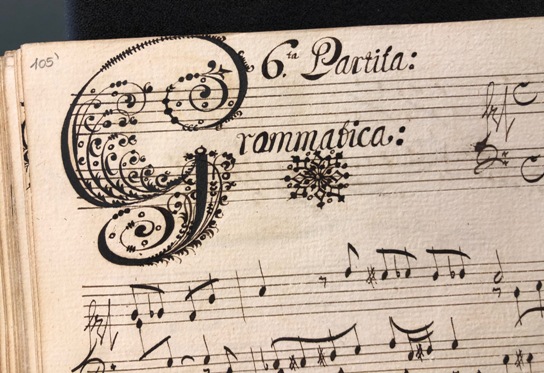Johann Jacob Froberger’s 1649 autograph manuscript – a presentation copy for Emperor Ferdinand III upon his return from studies in Rome – contains, in the position which should have been occupied by a sixth suite, a hybrid work: a Partita auff die Mayerin. This popular work, which Willi Apel justly characterized as “mediocre,” is a set of variations on a popular tune, some of which are given dance titles. The 6th variation now goes universally under the name Grammatica. Readers may wonder what Froberger had to do with Latin grammar. The answer is: nothing. The word is now taken as a delightful Austrian dialect corruption of cromatica. If this seems far-fetched, let them be informed that no less an authority than the Froberger Werkverzeichnis (FbWV) would have it so.
Unfortunately, FbWV is the ghastly, undigested work of a person of doubtful sanity, and has done incalculable damage to the understanding of this great composer’s corpus of masterpieces...not that more than a handful of people care. So what should Froberger’s chromatic variation on what is said to have been the half-wit emperor’s favorite tune actually be called? And wherefore – yea, quam ob rem Grammatica?
The strange title is a recent apparition, connected with FbWV. The most widely-used edition from the halcyon days of The Early Music Movement, that of Howard Schott (Paris, no date), has Crommatica, which certainly makes more sense. A doubled “m” doesn’t seem that outlandish, and the initial “G” could easily have been misread.
And yet...when one looks at the autograph itself, Grammatica seems to be the correct reading! The wildly ornamental title, as are all those in the 1649 and 1656 autographs, is in the hand of the calligrapher Johann Friedrich Sautter, whom Froberger knew from his Stuttgart days. The composer left ample space, where necessary, for his friend’s title fantasies after writing out the music. The first letter here is incontrovertibly a G, and the third letter is identical to the other two a’s.
So what has happened? To me it seems obvious that Sautter either reflexively, or through misunderstanding of a verbal instruction from Froberger, wrote a word that was familiar to every educated person at the time: Grammatica. But if one looks closely at his title, a discrete effort to change the third letter to an “o” by thickening the left-hand curve leaps out at the eye. Schott swallowed the result whole.
The initial G could not be changed without discarding two pages of music...hopefully the emperor wouldn’t notice, or couldn’t tell the difference? The dangling appendage surely might be taken as ornamental? In any case, the feebly disguised blunder stood. I only noticed it when looking at the original on a recent visit to Vienna, where the Österreichische Nationalbibliothek handed the priceless relic over to a pair of tourists for perusal at leisure. My wife could hardly believe it was the real thing, and wondered if it wasn’t a sophisticated facsimile. She later asked why there was no monument to such a great composer in Vienna. I answered that his greatness is not of a kind to be understood in this deplorable age, not even by professional harpsichordists. I was once again struck by all those pages of superb counterpoint, the largest section of the manuscripts, sandwiched in between the toccatas and the suites. Call me a curmudgeon, but I am glad to have the ricercars, fantasias and capriccios neglected by performers who can’t play an allemande in tempo, and who think a courante or a gigue is a race against the clock, and a sarabande a test of endurance.
The first modern edition by Guido Adler (Vol. 13 of his Denkmäler der Tonkunst in Österreich, 1899) is the only one that gets the title of the 6ta. Partita right. He simply says Cromatica, and nonsense be damned. But then, he was living in a supremely confident age, before the loss of nerve caused by the catastrophes of the 20th century – not to mention the collapse underway in the 21st, where editors elevate every slip of the pen to a Fassung, and musicology as a whole condemns every accomplishment of Western civilization as racist.
Adler, the Jewish founder of Austrian musicology, had a stupendous career that spanned an arc from encounters with Wagner and Liszt, harmony studies with Bruckner, and collaboration with Spitta on the first German musicological journal, to expulsion from his posts by the Nazis in 1938 and a premature report of his death in the odious Groß-Deutsch Lexikon der Juden in der Musik. Adler in fact only died in 1941. He was buried by his daughter, who perished at the hands of the Nazis a year later. Adler was the epitome of a quiet scholar. Gustav Mahler, a converted Jew himself, said, “When I want to be alone, I go for a walk with Guido Adler.”
I think there are a few palpable errors in Froberger’s remarkably careful music notation which have gone uncorrected in better editions than the sprawling disaster connected with FbWV. The point I am trying to make here goes beyond a quibble over a misreading. An absurdity such as Grammatica should never be allowed to get into print, where it then becomes canonical. I have found to my own embarrassment how nearly impossible it is to weed out the last error, even with the help of multiple professional proofreaders – a luxury of which Froberger could not have dreamt. But Grammatica and the other follies of FbWV, go far beyond the pale. One can only hope the recently-discovered autograph, intended by Froberger for Emperor Leopold I and sold at Sotheby’s to a hoarder, will someday fare better.
And while we’re on the subject: that portrait of Froberger which pops up everywhere is actually Ferdinand III. We don’t know what Hanß (as he signed himself) looked like.
June 27, 2021

|